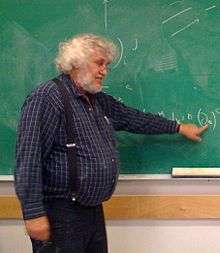W. G. Unruh
| William G. Unruh | |
|---|---|
 Unruh teaching "PHYS 407 - Introduction to General Relativity" at University of British Columbia (December 2008) | |
| Born |
William George Unruh 28 August 1945 Winnipeg, Manitoba, Canada |
| Citizenship | Canadian |
| Nationality | Canadian |
| Fields |
Theoretical physics General Relativity Quantum Mechanics |
| Institutions | University of British Columbia |
| Alma mater |
University of Manitoba (B.Sc.) Princeton University (M.A.)(Ph.D.) |
| Doctoral advisor | John Archibald Wheeler |
| Known for | Unruh effect |
| Notable awards |
Rutherford Memorial Medal (1982) Herzberg Medal (1983) Steacie Prize (1984) Steacie Fellowship (1984–1986) BC Science Council Gold Medal (1990) Royal Society Fellowship (2001) |

William George Unruh (born August 28, 1945) is a Canadian physicist at the University of British Columbia, Vancouver, who described the hypothetical Unruh effect in 1976.
Early life and education
Unruh was born in Winnipeg, Manitoba. He obtained his B.Sc. from the University of Manitoba in 1967, followed by an M.A. (1969) and Ph.D. (1971) from Princeton University, New Jersey, under the direction of John Archibald Wheeler.
Areas of research
Unruh has made seminal contributions to our understanding of gravity,[1][2] black holes,[3] cosmology, and quantum fields in curved spaces, including the discovery of what is now known as the Unruh effect. Unruh has contributed to the foundations of quantum mechanics in areas such as decoherence[4] and the question of time in quantum mechanics. He has helped to clarify the meaning of nonlocality in a quantum context, in particular that quantum nonlocality does not follow from Bell's theorem and that ultimately quantum mechanics is a local theory.[5] Unruh is also one of the main critics of the Afshar experiment.[6]
Unruh is also interested in music and teaches the Physics of Music.
The Unruh effect
The Unruh effect, described by Unruh in 1976, is the prediction that an accelerating observer will observe black-body radiation where an inertial observer would observe none.[3] In other words, the accelerating observer will find himself or herself in a warm background, the temperature of which is proportional to the acceleration. The same quantum state of a field, which is taken to be the ground state for observers in inertial systems, is seen as a thermal state for the uniformly accelerated observer. The Unruh effect therefore means that the very notion of the quantum vacuum depends on the path of the observer through spacetime.
The Unruh effect can be expressed in a simple equation giving the equivalent energy kT of a uniformly accelerating particle (with a being the constant acceleration), as:
References
- ↑ M. Choptuik & W. G. Unruh (1986). "An introduction to the Multi-Grid Method for Numerical Relativists". General Relativity and Gravitation. 18 (8): 813–843. Bibcode:1986GReGr..18..813C. doi:10.1007/BF00770203.
- ↑ W. G. Unruh & R. Wald (1989). "Time and the Interpretation of Canonical Quantum Gravity". Physical Review D. 40 (8): 2598–2614. Bibcode:1989PhRvD..40.2598U. doi:10.1103/PhysRevD.40.2598.
- 1 2 W. G. Unruh (1976). "Notes on Black Hole Evaporation" (PDF). Physical Review D. 14 (4): 870–892. Bibcode:1976PhRvD..14..870U. doi:10.1103/PhysRevD.14.870.
- ↑ W. G. Unruh & W. H. Zurek (1989). "Reduction of a wave packet in quantum Brownian motion". Physical Review D. 40 (4): 1071–1094. Bibcode:1989PhRvD..40.1071U. doi:10.1103/PhysRevD.40.1071.
- ↑ W. G. Unruh (2005). "Is Quantum Mechanics Non-Local?". Lecture at Green College, UBC.
- ↑ W. G. Unruh (2004). "Shahriar Afshar – Quantum Rebel?".
External links
- University of British Columbia Physics Dept. page
- Dr. Unruh's course webpage - PHYS 200 Introduction to Relativity and Quanta
- UBC Theoretical Physics Homepage - a web server ran by Unruh